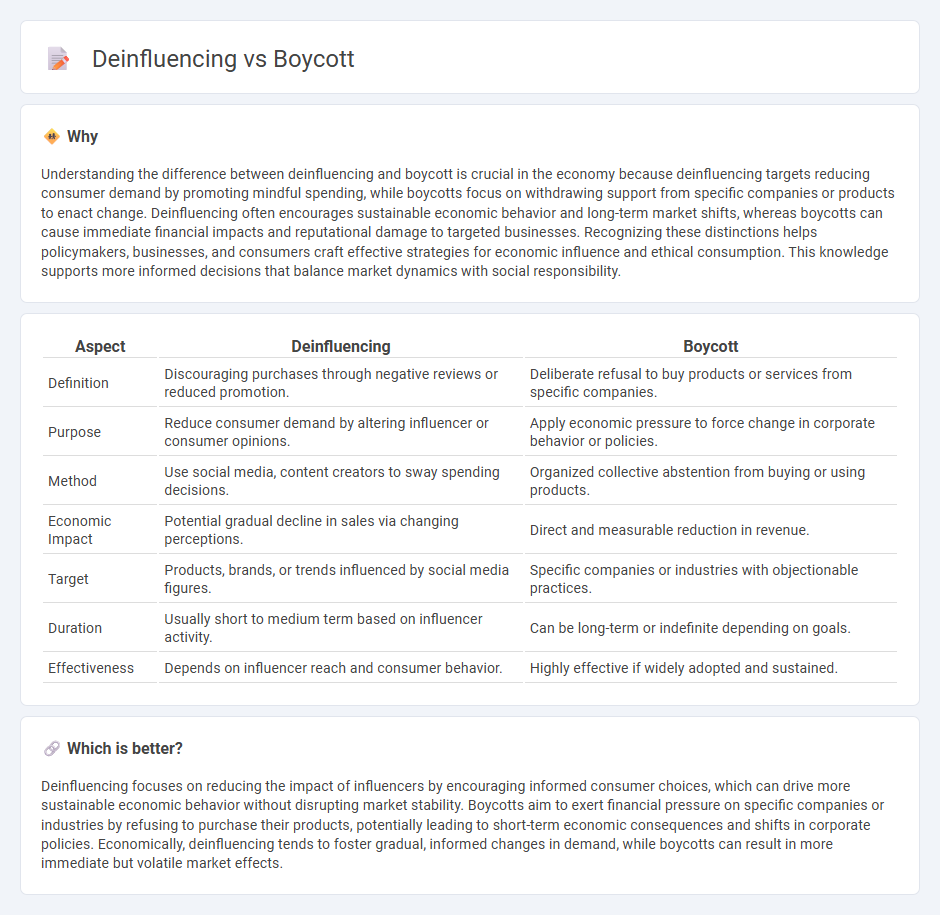
Deinfluencing represents a growing consumer trend where individuals critically reassess and reduce their reliance on influencers to guide purchasing decisions, contrasting with traditional boycotts that involve organized refusal to buy products or services for ethical, political, or economic reasons. Both strategies impact market demand and brand strategies by leveraging consumer autonomy to drive economic change. Explore the dynamics between deinfluencing and boycotts to understand their influence on contemporary economic behavior.
Why it is important
Understanding the difference between deinfluencing and boycott is crucial in the economy because deinfluencing targets reducing consumer demand by promoting mindful spending, while boycotts focus on withdrawing support from specific companies or products to enact change. Deinfluencing often encourages sustainable economic behavior and long-term market shifts, whereas boycotts can cause immediate financial impacts and reputational damage to targeted businesses. Recognizing these distinctions helps policymakers, businesses, and consumers craft effective strategies for economic influence and ethical consumption. This knowledge supports more informed decisions that balance market dynamics with social responsibility.
Comparison Table
| Aspect | Deinfluencing | Boycott |
|---|---|---|
| Definition | Discouraging purchases through negative reviews or reduced promotion. | Deliberate refusal to buy products or services from specific companies. |
| Purpose | Reduce consumer demand by altering influencer or consumer opinions. | Apply economic pressure to force change in corporate behavior or policies. |
| Method | Use social media, content creators to sway spending decisions. | Organized collective abstention from buying or using products. |
| Economic Impact | Potential gradual decline in sales via changing perceptions. | Direct and measurable reduction in revenue. |
| Target | Products, brands, or trends influenced by social media figures. | Specific companies or industries with objectionable practices. |
| Duration | Usually short to medium term based on influencer activity. | Can be long-term or indefinite depending on goals. |
| Effectiveness | Depends on influencer reach and consumer behavior. | Highly effective if widely adopted and sustained. |
Which is better?
Deinfluencing focuses on reducing the impact of influencers by encouraging informed consumer choices, which can drive more sustainable economic behavior without disrupting market stability. Boycotts aim to exert financial pressure on specific companies or industries by refusing to purchase their products, potentially leading to short-term economic consequences and shifts in corporate policies. Economically, deinfluencing tends to foster gradual, informed changes in demand, while boycotts can result in more immediate but volatile market effects.
Connection
Deinfluencing and boycotts intersect as consumers leverage social media to reject brands, reshaping economic demand and corporate strategies. This shift disrupts traditional marketing by promoting conscious spending and empowering collective action against harmful business practices. Brands face increasing pressure to align with ethical values, directly impacting revenue streams and market dynamics.
Key Terms
Consumer behavior
Boycott and deinfluencing both impact consumer behavior by encouraging individuals to withdraw support from specific products or brands, yet they differ in motivation and scale--boycotts typically arise from ethical or political stances, while deinfluencing centers on curbing excessive consumption influenced by social media trends. Consumer psychology reveals that boycotts leverage collective identity and moral alignment, whereas deinfluencing appeals to personal well-being and financial prudence. Explore deeper insights on how these strategies shape purchasing decisions and market dynamics.
Market demand
Boycott and deinfluencing both impact market demand by shifting consumer behavior, with boycotts targeting specific brands due to ethical or political reasons, while deinfluencing encourages reduced consumption based on sustainable or minimalistic values. Boycotts can cause immediate drops in sales and force companies to change practices, whereas deinfluencing promotes long-term demand adjustment by discouraging impulsive purchases and overconsumption. Explore the nuances of these consumer strategies and their effects on market dynamics to better understand evolving purchasing trends.
Social influence
Boycott and deinfluencing both leverage social influence but differ in intent and execution; boycott mobilizes collective consumer power to withdraw support from a brand or product as a form of protest, while deinfluencing involves influencers advising followers to avoid or reconsider purchases, often to promote authenticity or consumer awareness. Boycott campaigns rely on grassroots movements and collective action to impact brand reputation and sales directly, whereas deinfluencing focuses on micro-influencers or trusted voices shaping individual purchasing decisions through credibility and transparency. Explore the mechanics of social influence in shaping consumer behavior by diving deeper into boycott and deinfluencing strategies.
Source and External Links
Boycott - Wikipedia - A boycott is a nonviolent, voluntary abstention from buying a product or engaging with an entity as a form of protest, often to inflict economic loss or express moral outrage, named after Captain Charles Boycott from an 1880 Irish Land League campaign.
Boycotts | The First Amendment Encyclopedia - Free Speech Center - Boycotts are recognized by courts as protected political speech when aimed at social or political change, exemplified by the 1982 Supreme Court ruling that upheld the NAACP's civil rights boycott as protected under the First Amendment.
BDS Movement | BDS MOVEMENT - The Boycott, Divestment, Sanctions (BDS) movement seeks to end international support for Israel's policies by calling for boycotts, divestments, and sanctions targeting companies and institutions seen as complicit in the occupation of Palestinian territories.
 dowidth.com
dowidth.com